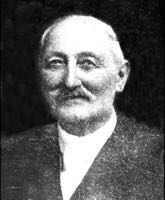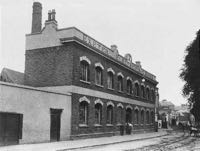
- Home
- Memories
- Scrapbook ▽
- Topics ▽
- People ▽
- Events
- Photos
- Site Map
- Timeline
Page updated 4th June 2017
Return to Industrial Exeter
It was in 1879, that Thomas Edison developed his first practical electric generator and who, over the next few years developed methods of switching and distribution that would lead to the practical use of electricity.
 An English pioneer
An English pioneerHenry Massingham was from Bath–the son of Henry Collyer Massingham who had a string of successful shoe shops, under the name of the Beehive Boot Stores.The young Henry, had witnessed the lighting of Bristol Cathedral with electricity in 1878, and was farsighted enough to see the potential of the new invention. He hired the generating equipment and set up a demonstration in Taunton which opened with street lighting on the 1st May and soon after, the Taunton Electric Light Company, signed as its first customer, the Castle Hotel. In 1887, Henry Massingham, canvassed local businesses on the creation of an electricity generating company for Exeter. He again set up a demonstration, with overhead wires on high poles in the High Street, Queen Street and St Sidwells–the result was the formation of the Exeter Electric Light Company.
Rockfield Works was the ideal building to set up the generating equipment and at a cost of £21,000, two AC and two DC generators installed along with a distribution system of 99 iron posts. The first customers were the new Theatre Royal which opened on 7 October 1889 as the first electrically lit theatre in the country. The generating equipment was capable of lighting 7,000 lamps of 8 candle power each, initially for shops and public buildings. Capacity was increased to 28,000 lamps, allowing houses within reach of the overhead wires, to install electric lights. The equipment was very basic, with a horizontal steam engine driving a rope coupled alternator, and a vertical steam engine, belt coupled to a Thomsom-Houston dynamo.
By 1896, the Company was short of cash for the heavy investment needed to expand the service, and the City Council stepped in by purchasing the electricity station for £7,500, to operate under the name of the City of Exeter Electric Company.
New equipment was delivered but it was not installed until July 1897. Meanwhile, Donald Cameron devised a system to install street lights between Exe Bridge and St Anne's Chapel, Sidwell Street, with Francis Parkin of Exe Island getting the contract for the cast iron lamp posts.
Concerns were growing for the viability of the Rockfield works–in 1896 they were producing 200kwh, and by 1899 the output had grown to 575kwh. Something had to be done, especially as the council were starting to think about an electric tram system for the city.
It was the need for more power for the planned introduction of the electric tram system that spelt the end for the Rockfield Works generating station. In 1899 the City looked into the possibility of generating electricity with a hydro-electric scheme at Trews Weir. However, fears that such an installation would affect the canal meant that the plans were shelved.
Finally, it was agreed that a generating station, at the head of the canal basin, at Haven Banks would be built. A site, 150ft square, was acquired in 1901, for £1,000 and a contract awarded to W Brealey of Exeter for the building. Constructed of brick, the building contained a boiler house, engine room and offices, along with an annexe for the economisers, feed pumps and a 155ft chimney at one end.
The main boiler room was 102ft by 55ft, lined with glazed bricks and a 'terrazzo' marble floor - architects were more interested in aesthetic design in those days for industrial buildings. Boilers from Babcock & Wilcox, steam engines from Bellis & Morcom, and generating machinery from the British Westinghouse Electric Manufacturing Co were installed. Local firm, Willey's were contracted to design and build the coal feed equipment and additional iron work. Lastly, cabling in stone lined conduits, from the power station throughout the city, was laid by Siemens Brothers of London.
Alongside the four new, steam driven alternators, the old boilers and generating equipment from New North Road were installed, to increase the capacity of the output. The New North Road building was sold in 1906. Coal was delivered by rail and ship, to be handled automatically through a gravity bucket conveyor system that fed it into 500 ton bunkers to be discharged onto the electrically driven mechanical stokers and into the furnace - the ash was automatically removed. For the time it was state of art.
In the usual grand Edwardian way, the new power station was opened by the Mayor, Cllr. Perry in 1905, who had a busy year, opening the new bridge across the Exe and driving the first tram! The works were designed from the start to allow for expansion, which was needed in 1906 when Heavitree was added to the 'Exeter grid'. In 1923, Topsham, which had its own belt driven DC generator up until then, was also added, along with Pinhoe, Alphington and Ide. In 1932 Kenn, Shillingford St George and Dunchideock were plugged into the Exeter supply.
In 1927 the output from the Haven Banks power station was 4,000kw and by 1930, it had increased dramatically to 15,350kw. However, it is the increase in consumers that best illustrates the growth of electricity use in Exeter.
| Year | Consumers |
| 1900 | 350 |
| 1906 | 1,100 |
| 1918 | 2,157 |
| 1930 | 18,463 |
The 1920s and 30s were a time of technological change, and for those who could afford it, the electrical age was a new, modern era. In 1936, the company was supplying 19,000 customers, through 300 miles of distribution cables, over an area of 41 square miles. They also supplied electricity to the Exe Valley and East Devon Electricity Companies.
To cater for the growing consumer demand, the City of Exeter Electric Company moved their offices at 184 Sidwell Street to 27 Dix's Field. They then opened a new showroom, on 7th October 1936, called Electricity House, in the old Woolworth's and Lloyds Tobacco Factory premises at the top of Fore Street, to the left of the present Chevalier Inn. At that time, many would hire their electrical equipment, and in the same year, 6,000 cookers, fires and other appliances were rented out. The showroom was destroyed in the 1942 bombing.
In 1947 the many independent, and often council run, electricity companies in the south west were nationalised, and the South West Electricity Board formed. Now, all the small, independent generating stations have been closed, with Haven Road closing in 1955 – the chimney was demolished in March 1960 and the turbines removed in 1961. The bulk of our electricity comes from the privately run, nuclear powered, Hinkley Point in Somerset. However, because of global warming, and an increasing reliance on gas to generate electricity, a new gas powered station is to open in Plymouth, and Cornwall has been at the forefront of generating electricity from wind turbines. The old generating station building at Haven Banks is the last to survive.
The Millhouse Partnership obtained planning consent to turn the main turbine hall into a hotel and to build seven self contained apartments at the southern end, on the original site of the chimney. In 2007, when work was in progress, in March 2007 arsonists caused thousands of pounds of smoke damage and the destruction of materials. After a delay, the apartments were completed in 2008. The hotel never materialised and the turbine hall has become an indoor climbing centre for the South West.
Sources: The SW Electricity Historical Society plus the 1905 opening programme of the Haven Banks Electricity Station, the 1936 opening programme for Electricity House, and a 1949 pamphlet on the SW grid, and Dick Passmore. © 2017 David Cornforth

The Exeter Electricity Co. building in New North Road, on the site of Longbrook House.
│ Top of Page │